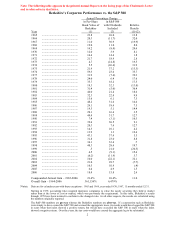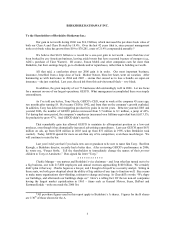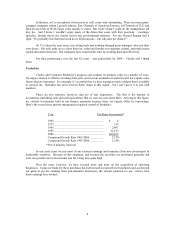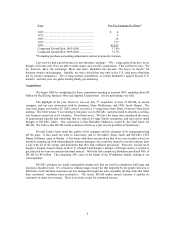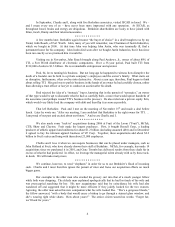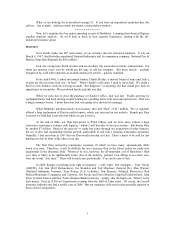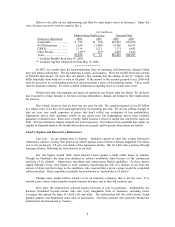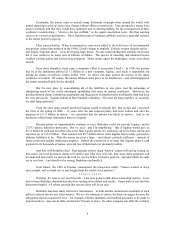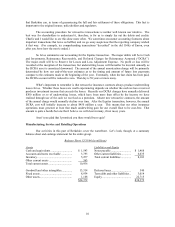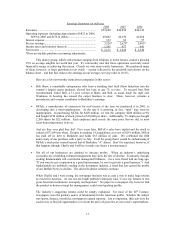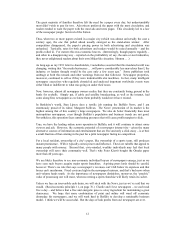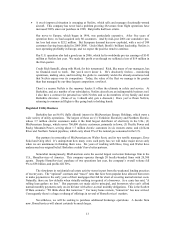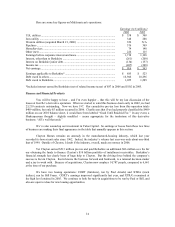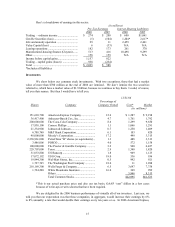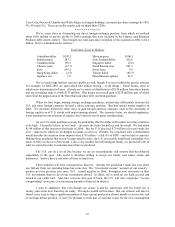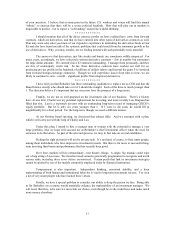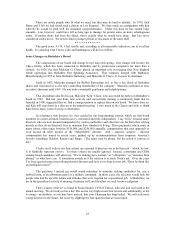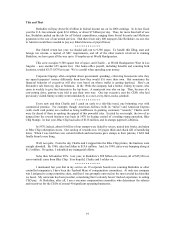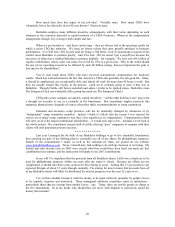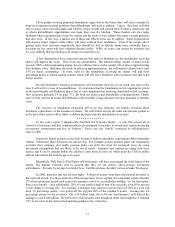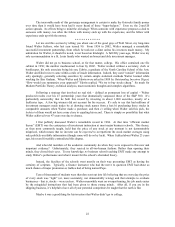Berkshire Hathaway 2006 Annual Report Download - page 13
Download and view the complete annual report
Please find page 13 of the 2006 Berkshire Hathaway annual report below. You can navigate through the pages in the report by either clicking on the pages listed below, or by using the keyword search tool below to find specific information within the annual report.The great majority of families therefore felt the need for a paper every day, but understandably
most didn’ t wish to pay for two. Advertisers preferred the paper with the most circulation, and
readers tended to want the paper with the most ads and news pages. This circularity led to a law
of the newspaper jungle: Survival of the Fattest.
Thus, when two or more papers existed in a major city (which was almost universally the case a
century ago), the one that pulled ahead usually emerged as the stand-alone winner. After
competition disappeared, the paper’ s pricing power in both advertising and circulation was
unleashed. Typically, rates for both advertisers and readers would be raised annually – and the
profits rolled in. For owners this was economic heaven. (Interestingly, though papers regularly –
and often in a disapproving way – reported on the profitability of, say, the auto or steel industries,
they never enlightened readers about their own Midas-like situation. Hmmm . . .)
As long ago as my 1991 letter to shareholders, I nonetheless asserted that this insulated world was
changing, writing that “the media businesses . . . will prove considerably less marvelous than I, the
industry, or lenders thought would be the case only a few years ago.” Some publishers took
umbrage at both this remark and other warnings from me that followed. Newspaper properties,
moreover, continued to sell as if they were indestructible slot machines. In fact, many intelligent
newspaper executives who regularly chronicled and analyzed important worldwide events were
either blind or indifferent to what was going on under their noses.
Now, however, almost all newspaper owners realize that they are constantly losing ground in the
battle for eyeballs. Simply put, if cable and satellite broadcasting, as well as the internet, had
come along first, newspapers as we know them probably would never have existed.
In Berkshire’ s world, Stan Lipsey does a terrific job running the Buffalo News, and I am
enormously proud of its editor, Margaret Sullivan. The News’ penetration of its market is the
highest among that of this country’ s large newspapers. We also do better financially than most
metropolitan newspapers, even though Buffalo’ s population and business trends are not good.
Nevertheless, this operation faces unrelenting pressures that will cause profit margins to slide.
True, we have the leading online news operation in Buffalo, and it will continue to attract more
viewers and ads. However, the economic potential of a newspaper internet site – given the many
alternative sources of information and entertainment that are free and only a click away – is at best
a small fraction of that existing in the past for a print newspaper facing no competition.
For a local resident, ownership of a city’ s paper, like ownership of a sports team, still produces
instant prominence. With it typically comes power and influence. These are ruboffs that appeal to
many people with money. Beyond that, civic-minded, wealthy individuals may feel that local
ownership will serve their community well. That’ s why Peter Kiewit bought the Omaha paper
more than 40 years ago.
We are likely therefore to see non-economic individual buyers of newspapers emerge, just as we
have seen such buyers acquire major sports franchises. Aspiring press lords should be careful,
however: There’ s no rule that says a newspaper’ s revenues can’ t fall below its expenses and that
losses can’ t mushroom. Fixed costs are high in the newspaper business, and that’ s bad news when
unit volume heads south. As the importance of newspapers diminishes, moreover, the “psychic”
value of possessing one will wane, whereas owning a sports franchise will likely retain its cachet.
Unless we face an irreversible cash drain, we will stick with the News, just as we’ ve said that we
would. (Read economic principle 11, on page 76.) Charlie and I love newspapers – we each read
five a day – and believe that a free and energetic press is a key ingredient for maintaining a great
democracy. We hope that some combination of print and online will ward off economic
doomsday for newspapers, and we will work hard in Buffalo to develop a sustainable business
model. I think we will be successful. But the days of lush profits from our newspaper are over.
12


